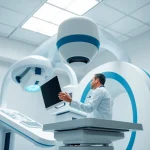
Understanding Mobile X-Ray Systems
What is a Mobile X-Ray System?
A mobile x-ray system is a radiographic device designed to be easily transported and utilized in a variety of healthcare settings. Unlike traditional fixed x-ray machines, these systems offer flexibility and convenience by providing imaging capabilities directly at the patient’s location, whether in a hospital room, emergency services, or remote clinics. Mobile x-ray systems typically integrate digital imaging technology, which enhances image quality and reduces radiation exposure. With their compact design and advanced features, these systems are revolutionizing the way medical imaging is conducted.
Benefits of Mobile X-Ray Technology
The advantages of mobile x-ray systems are numerous, making them an essential tool in modern healthcare. Here are key benefits:
- Speed and Efficiency: Mobile x-ray machines can be deployed quickly, enabling immediate imaging for urgent cases. This rapid diagnosis is critical in emergency situations.
- Patient Comfort: By bringing imaging services to the bedside, mobile x-ray systems minimize patient movement, reducing discomfort and anxiety, particularly for those with mobility issues.
- Infection Control: In settings like intensive care units or nursing homes, mobile x-ray systems mitigate the risk of infection by limiting patient transfers between locations.
- Cost-Effectiveness: Implementing mobile x-ray technology can lead to significant savings for healthcare facilities by reducing overhead costs associated with maintaining multiple fixed imaging rooms.
Key Features to Look For
When selecting a mobile x-ray system, certain features are critical to ensuring optimal performance and usability. These include:
- Image Quality: Look for systems that utilize advanced digital imaging technology, offering higher resolution and clearer images for accurate diagnosis.
- User-Friendly Interface: A straightforward, intuitive control panel can streamline operations, making it easier for technicians and radiologists to operate the system.
- Battery Life and Portability: Good mobile x-ray systems should have a long-lasting battery and lightweight design to facilitate transportation across various healthcare environments.
- Data Integration: The ability to seamlessly connect with electronic health records (EHR) systems ensures that images can be easily accessed and shared across platforms.
How Mobile X-Ray Systems Improve Patient Care
Quick Diagnosis and Treatment
The speed at which mobile x-ray systems can deliver diagnostic images plays a crucial role in patient management. For instance, in emergency departments, nurses and doctors can quickly assess injuries or conditions like pneumonia or fractures that require immediate intervention. Studies indicate that timely imaging significantly correlates with improved patient outcomes, helping streamline treatment plans and reduce hospital stays.
Enhanced Mobility and Accessibility
Mobile x-ray systems foster enhanced mobility within healthcare facilities, as they can be transported directly to patients unable to move due to their medical condition. This accessibility is particularly beneficial in geriatric care and palliative settings, where patients may need imaging but are physically incapable of traveling to the imaging department. By addressing these mobility challenges, healthcare providers can offer more comprehensive and compassionate care.
Reducing Patient Discomfort
For many patients, especially those in critical conditions, the thought of being moved for imaging can add to their stress and discomfort. Mobile x-ray systems eliminate the need for such transfers, reducing the physical and emotional burden on patients. The convenience and comfort of having medical imaging conducted in familiar surroundings dramatically improve the patient experience, promoting a more positive healthcare journey.
Implementation and Integration in Healthcare Facilities
Preparing Your Facility for Mobile X-Ray
Before integrating mobile x-ray systems into a healthcare facility, proper preparation is essential. Facilities must assess their infrastructure to accommodate the new technology. Key considerations include:
- Space Requirements: Ensure that areas where mobile units will operate have adequate space for safe maneuvering and patient handling.
- Power Supply: Confirm that sufficient power sources are available to charge batteries and operate the machines in all intended locations.
- Safety Protocols: Establishing safety measures to protect both patients and staff from radiation exposure is critical.
Training Staff for Effective Use
Successful integration of mobile x-ray systems hinges on staff training. Comprehensive training programs should include:
- Operating Procedures: Technicians should be well-versed in the specifics of operating the equipment, focusing on patient positioning, equipment handling, and troubleshooting potential issues.
- Radiation Safety: Staff must understand safety protocols to minimize radiation exposure, including the correct use of protective gear and distance measures.
- Emergency Protocols: In emergency situations, training should emphasize rapid deployment and usage, ensuring that staff can act without hesitation.
Integrating with Existing Systems
Mobile x-ray systems need to seamlessly integrate with a facility’s existing healthcare ecosystem. This requires thoughtful planning to ensure:
- Data Compatibility: Establish compatibility with existing electronic health records (EHR) and imaging software to streamline data management.
- Workflow Adjustments: Evaluate how mobile imaging can harmonize with current workflows, minimizing disruption while enhancing patient care.
- Feedback and Assessment: Regularly gathering feedback from users will help in assessing performance and guiding further improvements.
Cost-Effectiveness of Mobile X-Ray Solutions
Initial Investment vs. Long-Term Benefits
The initial purchase cost of mobile x-ray systems can be substantial, prompting many healthcare facilities to weigh their investment carefully. It’s important to evaluate:
- Cost of Traditional Systems: Analyzing the costs associated with maintaining multiple fixed x-ray rooms, including staffing, maintenance, and potential downtime.
- Patient Throughput: Mobile x-ray systems can increase the number of patients imaged daily, impacting revenue positively over time.
- Reduction in Transfers: Savings in manpower and logistical costs due to fewer patient transfers to and from imaging departments also contribute to the overall cost-effectiveness.
Comparing Costs with Traditional X-Ray Systems
When comparing mobile x-ray systems with traditional x-ray machines, it is essential to consider both upfront and ongoing costs. Mobile systems often lead to:
- Lower Operational Costs: Fewer fixed locations mean lower overhead expenses for staff and equipment maintenance.
- Reduced Infrastructure Needs: Traditional systems require dedicated spaces, which can incur additional costs in real estate and renovations.
- Increased Revenue Potential: The ability to serve more patients and decrease wait times can directly lead to higher service volume and revenue.
Return on Investment Analysis
Calculating the return on investment (ROI) for mobile x-ray systems involves assessing various metrics:
- Cost Savings: Estimate how much mobile imaging reduces transportation costs and associated staff hours.
- Enhanced Productivity: Evaluate the increase in patient imaging capacity and its impact on revenue generation.
- Improved Patient Outcomes: Consider how timely diagnoses lead to better treatment results and potentially lower costs associated with complications or extended hospital stays.
Future Trends in Mobile X-Ray Technology
Innovations on the Horizon
The field of medical imaging is continuously evolving, and mobile x-ray systems are at the forefront of this innovation. Expected advancements include:
- Artificial Intelligence (AI): Integrating AI for image analysis and interpretation could significantly speed up diagnosis and reduce human error.
- Enhanced Imaging Techniques: New imaging technologies, including 3D x-rays, are set to improve diagnostic capabilities even further.
- Tele-imaging: Connective technologies that allow for remote image reviews by radiologists, ensuring timely assessments regardless of location.
Expanding Applications in Telemedicine
The rise of telemedicine has greatly expanded the applications of mobile x-ray systems. Healthcare providers increasingly rely on mobile imaging to serve patients in remote and underserved areas. This trend will enhance:
- Access to Care: Patients in rural locations no longer need to travel long distances for basic imaging services.
- Rapid Response in Emergencies: Mobile x-ray solutions can be deployed quickly in disaster zones or areas where local facilities are overwhelmed.
- Cost-Effective Solutions: Telemedicine offers a cost-effective approach to offer services that might otherwise be financially unfeasible for small clinics.
Regulatory Advances and Industry Standards
As mobile x-ray technology advances, so too do the regulations governing its use. Upcoming trends include:
- Standardization of Safety Protocols: With stricter guidelines from health authorities, manufacturers will need to align their products with the latest safety standards.
- Enhanced Training Requirements: Policymakers are increasingly emphasizing thorough training programs for healthcare workers involved in mobile imaging.
- Data Security Regulations: As mobile x-ray systems increasingly connect to larger networks, regulations regarding patient data security and interoperability will become paramount.







